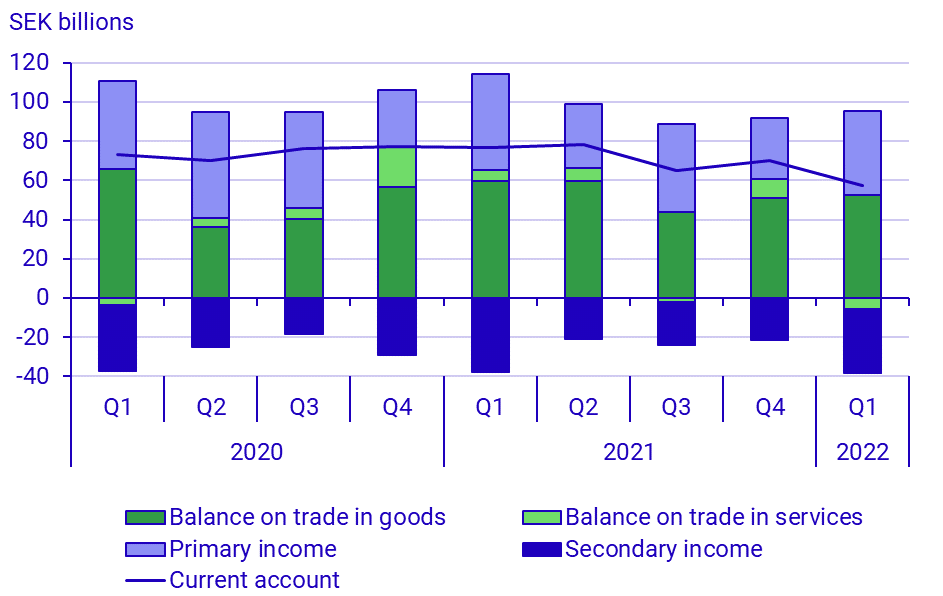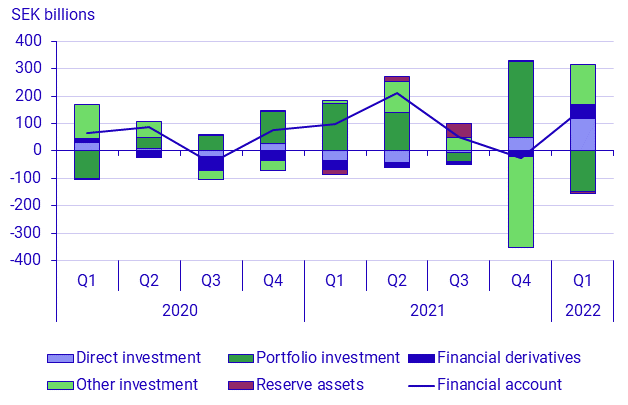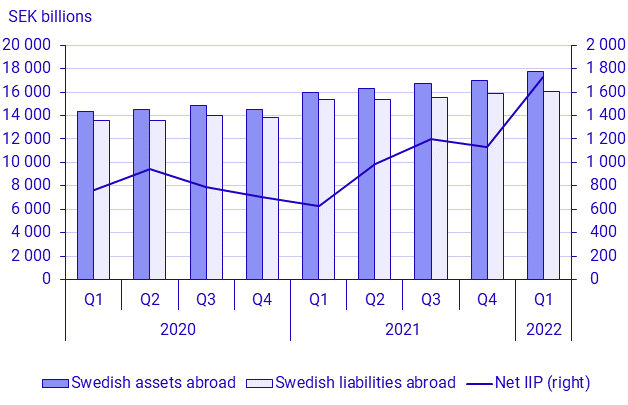Balance of payments, 1st quarter 2022
Increased international investment position due to negative stock market development
Statistical news from Statistics Sweden 2022-06-07 8.00
Sweden’s net external assets position amounted to SEK 1 724.6 billion at the end of the first quarter of 2022. It is an increase of SEK 590.2 billion compared with the previous quarter. The current account surplus amounted to SEK 57.5 billion during the quarter, a decrease of SEK 19.3 billion compared with the corresponding quarter a year ago. Lower trade in services was a contributing factor.
“The main reason for the increased international investment position is that the decline on the Swedish stock market during the first quarter of 2022 was larger than the decline in international stock markets”, says Linda Nihlwing, economist at the Balance of Payments unit.
The current account surplus decreased by SEK 19.3 billion during the quarter compared with the first quarter of 2022. Trade in goods and services and primary income contributed to the decreased surplus, which was partially offset by increases in the secondary income. The financial account shows that net lending with the rest of the world amounted to SEK 157.4 billion during the quarter.
What is the balance of payments?
The balance of payments is a statement of all Swedish transactions with the rest of the world. It presents exports and imports of goods and services. It also includes a description of changes in financial assets and liabilities with the rest of the world. The balance of payments consists of the current account, the financial account, and the capital account. The component parts of the balance of payments and related terms are explained under Definitions and explanations, at the end of this item of statistics news.
Current account surplus as share of Sweden’s GDP
In the first quarter of 2022, Sweden’s current account as a share of GDP decreased to 4.9 percent of Sweden’s GDP, calculated as a moving average over the last four quarters.

Comparisons between periods in the current account are made using the corresponding quarter the previous year.
Exports and imports of goods increased
Trade in goods showed a surplus of SEK 52.4 billion in the first quarter of 2022. This is a decrease of SEK 7.1 billion compared with the first quarter of 2021. Exports of goods amounted to SEK 516.9 billion, which is an increase of SEK 91.3 billion compared with the corresponding quarter a year ago. Imports of goods amounted to SEK 464.4 billion, up by SEK 98.3 billion in a corresponding comparison.
Surplus in merchanting, which is included in the balance on trade in goods, increased by SEK 3.5 billion compared with the first quarter of 2021. The surplus thus amounted to SEK 39.9 billion in the first quarter of 2022.
Imports and exports of services increased
Trade in services noted a deficit of SEK 5.7 billion. This can be compared with a surplus of SEK 6.0 billion in the corresponding quarter last year. Both exports and imports of services noted large increases in the first quarter of 2022 in a corresponding comparison. The extensive growth in imports of services contributed to a low balance on trade in goods.
Import of services amounted to SEK 191.4 billion, up by SEK 45.3 billion compared with the first quarter of 2021. At the same time, export of services noted an increase of SEK 33.6 billion in a corresponding comparison and amounted to SEK 185.7 billion.
Primary income surplus narrowed
Primary income, which consists mainly of compensation of employees and investment income, presented a surplus of SEK 43.1 billion in the first quarter of 2022. This surplus narrowed by SEK 5.6 billion compared with the corresponding quarter a year ago. Investment income is the main part of primary income that contributed to this change through a decreased surplus. The surplus in investment income went from SEK 45.9 billion in the first quarter of 2021 to SEK 39.6 billion in the first quarter of 2022.
Portfolio investment contributed a surplus of SEK 14.2 billion to investment income, a decrease of SEK 7.7 billion compared with the corresponding quarter a year ago. Investment income on direct investment contributed a surplus of SEK 26.7 billion, which is an increase of SEK 0.6 billion in a corresponding comparison.
Secondary income deficit narrowed
Secondary income, which includes international cooperation and donations and contributions to the EU, presented a deficit of SEK 32.4 billion. This deficit narrowed by SEK 5.1 billion compared with the corresponding quarter a year ago. During the first quarter of 2021, the fee to the EU was temporarily higher due to a delay in the reduction of the EU fee and extra fees linked to the pandemic.
Net lending in the financial account
The financial account presented net lending amounting to SEK 157.4 billion in the first quarter of 2022. Net lending and net borrowing refer to the overall balance on the financial account.
In the financial account, direct investment, financial derivatives and other investment noted net lending, while portfolio investment noted net borrowing. Reserve assets noted decreased net lending during the first quarter of 2022.

Direct investment increased both in Sweden and abroad
Net lending in direct investment amounted to SEK 119.6 billion during the quarter. Foreign direct investment in Sweden increased by SEK 43.8 billion and Swedish direct investment abroad increased by SEK 163.4 billion.
Portfolio investment increased in Sweden and decreased abroad
Net borrowing in portfolio investment amounted to SEK 147.1 billion during the quarter. Foreign investors increased their portfolio investment in Sweden by SEK 50.5 billion, and Swedish investors decreased their portfolio investment abroad by SEK 96.5 billion.
Other investment increased in Sweden and abroad
Net lending in other investment corresponded to SEK 143.7 billion. Swedish other investment abroad increased by SEK 474.6 billion, and foreign other investment in Sweden increased by SEK 330.9 billion.
Financial derivatives and reserve assets
Net lending in financial derivatives amounted to SEK 51.3 billion. Reserve assets noted decreased net lending corresponding to SEK 10.2 billion.
Net assets in Sweden’s international investment position increased
Sweden’s net external assets position amounted to SEK 1 724.6 billion, which is a large increase compared with SEK 1 134.4 billion in the previous quarter. The major change during the quarter was largely due to portfolio investments, going from net external liabilities to net external assets. The decline on the Swedish stock market has been greater than the decline in international stock markets during the first quarter of 2022. As a result, foreign assets in Sweden decreased more in value than Swedes’ assets abroad.

Swedish external assets and liabilities increased
Swedish external assets amounted to SEK 17 733.4 billion, an increase of SEK 762.6 billion compared with the previous quarter. Swedish external liabilities increased by SEK 172.3 billion compared with the previous quarter and amounted to SEK 16 008.8 billion.
Direct investment, financial derivatives and other investment increased both in Sweden and abroad. Reserve assets decreased abroad. Portfolio investment decreased both in Sweden and abroad. The largest net external assets were in reserve assets, direct investment and other investment.
Revisions
The time series for the Balance of Payments and the international investment position has been revised from Q1 2018.
Improvements have been made regarding calculations of transactions for different types of securities within portfolio investment. This affects the time series from Q1 2021 onwards.
The Balance of Payments adheres to a predetermined revision policy, see Section 2.3 in the 2022 Quality Declaration.
Kvalitetsdeklaration, Betalningsbalans och utlandsställning, 2022 (scb.se).
In a compilation of the balance of payments and the international investment position, data based on forecasts are used in some cases. These statistics will be updated as results are received. If new data is added or in the case of any methodological changes, further revisions are carried out as necessary.
Revisions carried out in connection with publication of the first quarter of 2022 are listed in the tables on revisions by account item for the balance of payments and the international investment position, respectively.
Definitions and explanations
The current account and the financial account record real and financial transactions with regard to the rest of the world. Only proper transactions are recorded; value changes, such as exchange rate fluctuations are excluded.
The current account shows the trade in goods (foreign trade in goods), the trade in services (foreign trade in services), primary income (compensation to employees, investment income, other primary income), and secondary income (current transfers). Surplus and deficit in the current account refer to the difference between Sweden’s exports and Sweden’s imports. A positive outcome results in a surplus, while a negative outcome results in a deficit. Comparisons between periods in the current account are always made using the corresponding quarter the previous year, due to seasonal patterns in data.
The financial account consists of direct investment, portfolio investment, financial derivatives, other investment, and reserve assets. Sweden can acquire and dispose of financial assets abroad. All transactions during the quarter concerning external assets show Sweden’s change in net external assets. Sweden can also borrow and repay financial external liabilities. All transactions during the quarter concerning external liabilities show Sweden’s change in net external liabilities. The difference between Sweden’s change in net external assets and Sweden’s change in net external liabilities can be positive or negative, and shows net lending and net borrowing, respectively.
The capital account records Sweden’s capital transfers and transfers of non-financial assets with regard to the rest of the world. Compared with other parts of the balance of payments, amounts in the capital account are usually small.
The difference between Sweden’s financial external assets and liabilities position is the net of Sweden’s international investment position, which can be positive or negative.
An increase or decrease in assets describes Sweden’s external assets. An increase or decrease in liabilities describes Sweden’s external liabilities.
Merchanting, which forms a part of the trade in goods, refers to triangular trade in which goods are purchased and sold abroad without the good crossing a Swedish border.
Statistical Database
More information is available in the Statistical Database
Feel free to use the facts from this statistical news but remember to state Source: Statistics Sweden.
